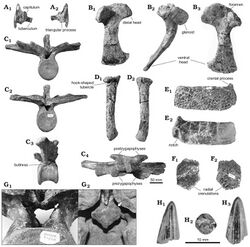Biology:Dakotasuchus
| Dakotasuchus | |
|---|---|

| |
| Fossils from Utah | |
| Scientific classification | |
| Missing taxonomy template (fix): | Archosauria/Reptilia |
| Clade: | Pseudosuchia |
| Clade: | Crocodylomorpha |
| Clade: | Crocodyliformes |
| Family: | †Goniopholididae |
| Genus: | †Dakotasuchus Mehl, 1941 |
| Type species | |
| †Dakotasuchus kingi Mehl, 1941
| |
Dakotasuchus (meaning "Dakota [Sandstone] crocodile") is a genus of goniopholidid mesoeucrocodylian. Its fossils have been recovered from the Cenomanian-age Upper Cretaceous Dakota Sandstone of Kansas .[1] The type specimen was found in an iron-cemented sandstone concretion near Salina. This concretion was broken into two large pieces; more of the specimen was probably present originally, but by the time it was found only the torso and short portions of the neck and tail remained. Twenty pairs of bony scutes ran down the midline of the back.[2][3] The vertebrae lacked the procoelous articulation (concave anterior and convex posterior faces) of more derived crocodyliforms. Dakotasuchus had short broad shoulder blades, suggesting it had stout powerful forelimbs and perhaps terrestrial habits. M. G. Mehl, who described the genus, estimated the length of the type individual when complete to have been 3–4 metres (9.8–13.1 ft). The type species is D. kingi, named for Professor King, a former dean of Kansas Wesleyan University.[4] Mehl did not classify his new genus to a more inclusive group than Mesosuchia (a paraphyletic group replaced by Mesoeucrocodylia). Robert Carroll assigned Dakotasuchus to Goniopholididae in 1988.[5] In 2017, fossils of Dakotasuchus kingi which consisted of a coracoid, scutes, a dorsal vertebrate and postcranial bones were found in Utah, specifically in the Cedar Mountain Formation's Mussentuchit Member.[6]
References
- ↑ Vaughn, Peter Paul (1956). "A Second Specimen of the Cretaceous Crocodile Dakotasuchus from Kansas". Transactions of the Kansas Academy of Science 59 (3): 379. doi:10.2307/3626613. ISSN 0022-8443. http://dx.doi.org/10.2307/3626613.
- ↑ Everhart, Mike. "Dakotasuchus kingi and other crocodiles from Kansas: Life along the shores of the Late Cretaceous Western Interior Sea". http://oceansofkansas.com/KS_Crocodiles.html.
- ↑ "Untitled Document". http://www.paleofile.com/Mesosuchia/Dakotasuchus.asp.
- ↑ Mehl, M. G. (1941). "Dakotosuchus kingi, a crocodile from the Dakota of Kansas". Journal of the Scientific Laboratories, Denison University 36 (3): 47–65.
- ↑ Carroll, Robert L. (1988). Vertebrate Paleontology and Evolution. W.H. Freeman and Company. ISBN 0-7167-1822-7. https://archive.org/details/vertebratepaleon0000carr.
- ↑ Frederickson, Joseph; Cohen, Joshua; Hunt, Tyler; Cifelli, Richard (2017). "A new occurrence of Dakotasuchus kingi from the Late Cretaceous of Utah, USA, and the diagnostic utility of postcranial characters in Crocodyliformes". Acta Palaeontologica Polonica 62. doi:10.4202/app.00338.2016. ISSN 0567-7920. http://dx.doi.org/10.4202/app.00338.2016.
Wikidata ☰ Q5210067 entry
 |

